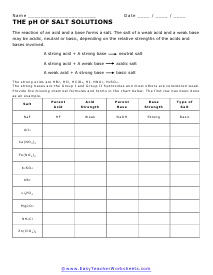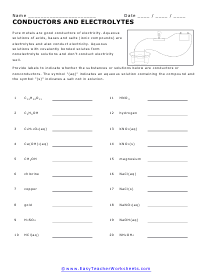You will learn how to identify acids and bases based on their chemical symbol and you will learn to predict where they might fall on the pH scale. You will also begin to realize the relative strength of these substances based on the nature of the elements that are involved. You will also learn how the nature of a liquid can help you understand if they are good conductors of electricity. The worksheets work on identifying acids and bases based on a number of different criteria and your understanding of ion transfer.
Print Acid and Base Worksheets
Click the buttons to print each worksheet and associated answer key.

Are They Acids, Bases, or Salts?
Classify each of the following substances as an acid, a base or a salt. You will need to look at the elements that are in each compound and determine how likely it is to give off a hydrogen ion.

Understanding the pH Scale
Identify whether the solutions listed below are acids or bases. Write the color expected for each indicator (phenolphthalein, litmus dye) when immersed and indicate the pH range you would expect. While indicators such as phenolphthalein and litmus are not an exact tool, they can give a general idea of the nature of a substance.

Classify the Compounds
Determine the nature of each compound and determine if it would be weak or strong. Some of these will be classified as salts.

pH Classification and Indicators
We work to identify liquids that would meet all these different pH values. Then we predict how they would react around common indicators. Work on figuring out how each pH level would react with Blue Litmus, Phenolphthalein, and Red Litmus.

pH of Salt Solutions
Salts are given off as a byproduct as a result of a reaction between these two classes of liquids. The strong bases are the Group I and Group II hydroxides and most others are considered weak. Provide the missing chemical formulas and terms in the chart below.

Conductors and Electrolytes
Which substance would allow current to travel in the presence of water? Which of them do not need to be an aqueous solution?
What Are Acids and Bases?
Acids and bases are substances we encounter daily. Vinegar, bleach, baking soda, and cola are a few common examples.
Acids and bases are chemical substances that react with each other and may affect pH levels. Acids are characteristically sour, corrosive, and neutralized by bases. The definitions of acids and bases depend on the Arrhenius, Brønsted-Lowry, and Lewis theories.
Liquids are classified as acids, bases, or neutral based on the concentration of hydrogen ions present in it. If a substance is neutral it has an equal amount of positive and negative ions present in it. If a liquid has a greater concentration of positive ions in the form of hydrogen than say water, it is classified as an acid. If the liquid has less hydrogen ions than water, it is a base. An acid and a base can be used to neutralize one another. When this occurs salt and water are formed. By the time we are ready for school, we have all heard the about acids and how bad they are. Many acids are very helpful to use in everyday life. When looking at acids and bases we are completely worried about the change or transfer of hydrogen or hydroxide ions. If a particular substance has many hydrogen ions, it is an acid. If it has a bunch of hydroxide ions, it’s a base. We use a pH scale to classify substance that ranges from 0 to 14, with 7 being neutral (meaning neither an acid nor a base. The closer a substance is to 0, the more of an acid it is. The closer to 14 a substance is, the more it is a base.
What Are Arrhenius Acids and Bases?
Svante Arrhenius provided the first and most basic definition of acids and bases in 1884.
Arrhenius acids are compounds that release hydrogen ions (H+), while Arrhenius bases are those that release hydroxyl ions (OH-). The reaction of such acids and bases leads to salts and water. However, it is limited.
Arrhenius Reactions
The general equation of an Arrhenius acid reaction is HA → H+ + A-. Meanwhile, the one for bases is BOH → B+ + OH-. Although these equations clearly illustrate how the ions dissociate, in reality, sole hydrogen ions don't exist alone in solutions. Usually, they are attracted to water and form H3O+ or hydronium.
Arrhenius Theory Limitations
While Arrhenius' definitions are straightforward, they are limited because they do not explain certain phenomena.
For instance, the weak base ammonia (NH3), a common component of fertilizers, would not fit into the Arrhenius definition because it does not release OH-. Despite this, it is a base because it reacts with hydrochloric acid (HCl) acids.
Arrhenius Acids and Bases Example
A typical example of Arrhenius acids and bases is the reaction between sodium hydroxide (NaOH), a base, and hydrochloric acid (HCl), an acid:
NaOH + HCl → NaCl + H2O
The reaction produced both water and salt. Water was formed from the H+ and OH- ions released by the acid and base, respectively.
What Are Brønsted-Lowry Acids and Bases?
The limitations of Arrhenius's theory are addressed in Brønsted-Lowry definitions.
Brønsted-Lowry acids are proton donors, while Brønsted-Lowry bases are proton acceptors. In this theory, a proton is defined as a single hydrogen ion (H+), and amphoteric substances act as both acids and bases. The definition of Brønsted-Lowry may apply to the Arrhenius substances.
Brønsted-Lowry Theory Reaction and Example
An example equation is best to understand the reaction between Brønsted-Lowry acids and bases:
NH3 + H2O ⇆ NH4+ + OH-
In the given reaction, water acts as an acid by providing ammonia with a proton to form ammonium. Thus, ammonia is the base because it is the proton acceptor.
Conjugate Acids and Bases
When acids and bases dissociate, they form their conjugate compound. For the reaction above, the conjugate acid of ammonia is ammonium. Meanwhile, the conjugate base of water is hydroxyl.
It is also important to note that conjugate compounds have an inverse relationship. Strong acids have weak conjugate bases, while strong bases have weak conjugate acids.
Brønsted-Lowry Theory Limitations
While the Brønsted-Lowry theory is more inclusive than the Arrhenius, it still has limitations. It cannot explain why compounds like boron trifluoride (BF3) or aluminum (III) chloride (AlCl3) can act as acids without protons. It also does not cover reactions between acid and base oxides.
What Are Lewis Acids and Bases?
Unlike the previous theories, Lewis acid and base definitions do not involve the exchange of ions like H+.
A Lewis acid accepts electron pairs while a Lewis base donates them. There is no need for the transfer of ions like H+. Thus, it considers proton-less compounds like boron trifluoride (BF3) to be acids because they accept electron pairs.
The Lewis theory encompasses the previous theories. Thus, Arrhenius or Brønsted-Lowry acids are also considered Lewis acids.
Lewis Theory Example
The best way to illustrate the Lewis theory is through the reaction of boron trifluoride with ammonia:
BF3 + NH3 → H3NBF3
In this reaction, BF3 receives electron pairs from NH3. It results in a compound with a coordinate covalent bond.
The Lewis theory also explains the formation of complex ions or coordination compounds. It can involve metals, like aluminum.
Final Thoughts
Three different definitions of acids and bases are based on Arrhenius, Brønsted-Lowry, and Lewis's theories. Each theory becomes increasingly comprehensive than the other. The most comprehensive one, Lewis's theory, allows scientists to identify substances better and thereby predict reactions.


